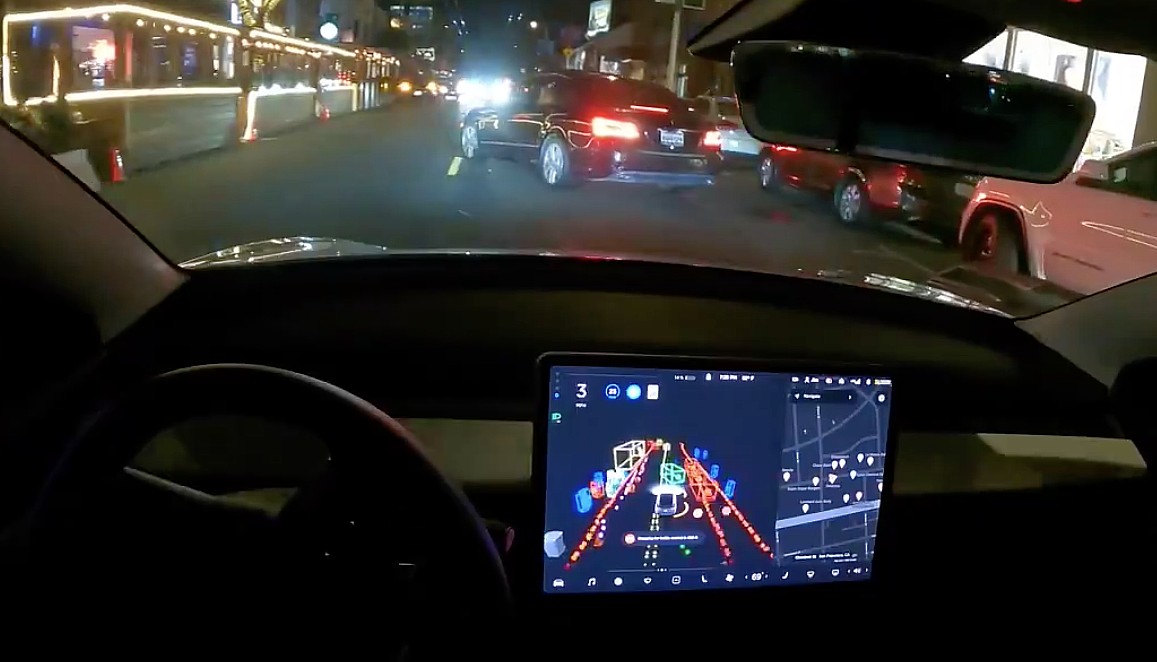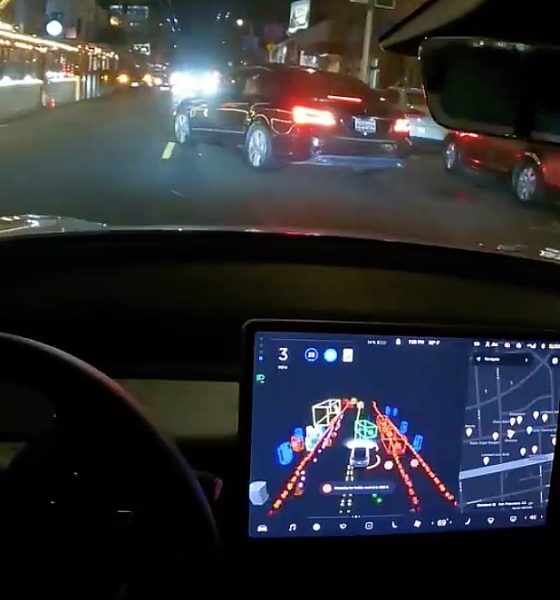

News
Facebook CTO shares insights on Tesla’s shift to pure vision for Autopilot
Tesla’s decision to abandon radar and focus instead on a pure vision strategy in its efforts to achieve self-driving features may be controversial even among the company’s most ardent fans, but Facebook CTO Mike Schroepfer seems to be on the EV maker’s side. In a series of posts on Twitter, the Facebook CTO shared his thoughts on Tesla’s bold strategy and why it may actually work.
Schroepfer, who is known for his work on artificial technology for Facebook, noted that Tesla’s pure vision approach is actually pretty clever. This is because Tesla has the ability to capture and label data at a fleet-wide scale. He also reiterated a point that Elon Musk previously made on Twitter—that sensor fusion becomes tricky, especially when two sensors disagree.
Given Tesla's ability to capture and label data at fleet-wide scale this is a smart approach. Computer Vision continues to advance quickly and we have a proof point in that human drivers don't need radar :).
— Mike Schroepfer (@schrep) May 25, 2021
Granted, radar has played a key role in improving the safety of Tesla’s vehicles. Numerous Tesla owners over the years have remarked that their vehicles’ radar has detected hazards on the road in situations where pure vision would have been compromised. It would now be up to the company to prove that its vehicles could maintain their safety even after losing radar; or better yet, improve their safety after losing the sensor.
Ultimately, Schroepfer also highlighted that humans drive vehicles with mostly vision alone. And while it is true that a well-rested, focused, and trained human driver would be excellent on the road, very rarely do drivers tick all three boxes at all times. This is proven by the fact that a good number of accidents on the road could be attributed to distracted driving or exhausted drivers. Computers, such as those used by Tesla, have the potential to tick all three boxes all the time.
Cost is what makes the difference between mass scale and not. External tracking using lasers gives you "actual distance" for Virtual Reality – but it wasn't until we shipped a $299 inside-out tracked VR headset "only" based on CV that VR is becoming real. Scale matters
— Mike Schroepfer (@schrep) May 25, 2021
In previous comments, Elon Musk has noted that a move to pure vision should help Tesla’s Autopilot and Full Self-Driving system improve significantly. The CEO hinted at some of the issues that such a change could address, such as phantom braking. However, Tesla is still maintaining its cautious stance amidst its shift, as evidenced by the company’s restrictions on features such as Autosteer when the pure vision update rolls out.
As per the EV maker, for a short period during the transition to pure vision, vehicles with no radar would have some features temporarily limited or inactive. These include Autosteer, which would be limited to 75 mph and a longer minimum following distance. Smart Summon and Emergency Lane Departure Avoidance may be disabled at delivery as well. These features would then be restored as over-the-air updates are deployed.
Don’t hesitate to contact us for news tips. Just send a message to tips@teslarati.com to give us a heads up.

News
Tesla FSD fleet is nearing 7 billion total miles, including 2.5 billion city miles
As can be seen on Tesla’s official FSD webpage, vehicles equipped with the system have now navigated over 6.99 billion miles.

Tesla’s Full Self-Driving (Supervised) fleet is closing in on almost 7 billion total miles driven, as per data posted by the company on its official FSD webpage.
These figures hint at the massive scale of data fueling Tesla’s rapid FSD improvements, which have been quite notable as of late.
FSD mileage milestones
As can be seen on Tesla’s official FSD webpage, vehicles equipped with the system have now navigated over 6.99 billion miles. Tesla owner and avid FSD tester Whole Mars Catalog also shared a screenshot indicating that from the nearly 7 billion miles traveled by the FSD fleet, more than 2.5 billion miles were driven inside cities.
City miles are particularly valuable for complex urban scenarios like unprotected turns, pedestrian interactions, and traffic lights. This is also the difference-maker for FSD, as only complex solutions, such as Waymo’s self-driving taxis, operate similarly on inner-city streets. And even then, incidents such as the San Francisco blackouts have proven challenging for sensor-rich vehicles like Waymos.
Tesla’s data edge
Tesla has a number of advantages in the autonomous vehicle sector, one of which is the size of its fleet and the number of vehicles training FSD on real-world roads. Tesla’s nearly 7 billion FSD miles then allow the company to roll out updates that make its vehicles behave like they are being driven by experienced drivers, even if they are operating on their own.
So notable are Tesla’s improvements to FSD that NVIDIA Director of Robotics Jim Fan, after experiencing FSD v14, noted that the system is the first AI that passes what he described as a “Physical Turing Test.”
“Despite knowing exactly how robot learning works, I still find it magical watching the steering wheel turn by itself. First it feels surreal, next it becomes routine. Then, like the smartphone, taking it away actively hurts. This is how humanity gets rewired and glued to god-like technologies,” Fan wrote in a post on X.
News
Tesla starts showing how FSD will change lives in Europe
Local officials tested the system on narrow country roads and were impressed by FSD’s smooth, human-like driving, with some calling the service a game-changer for everyday life in areas that are far from urban centers.

Tesla has launched Europe’s first public shuttle service using Full Self-Driving (Supervised) in the rural Eifelkreis Bitburg-Prüm region of Germany, demonstrating how the technology can restore independence and mobility for people who struggle with limited transport options.
Local officials tested the system on narrow country roads and were impressed by FSD’s smooth, human-like driving, with some calling the service a game-changer for everyday life in areas that are far from urban centers.
Officials see real impact on rural residents
Arzfeld Mayor Johannes Kuhl and District Administrator Andreas Kruppert personally tested the Tesla shuttle service. This allowed them to see just how well FSD navigated winding lanes and rural roads confidently. Kruppert said, “Autonomous driving sounds like science fiction to many, but we simply see here that it works totally well in rural regions too.” Kuhl, for his part, also noted that FSD “feels like a very experienced driver.”
The pilot complements the area’s “Citizen Bus” program, which provides on-demand rides for elderly residents who can no longer drive themselves. Tesla Europe shared a video of a demonstration of the service, highlighting how FSD gives people their freedom back, even in places where public transport is not as prevalent.
What the Ministry for Economic Affairs and Transport says
Rhineland-Palatinate’s Minister Daniela Schmitt supported the project, praising the collaboration that made this “first of its kind in Europe” possible. As per the ministry, the rural rollout for the service shows FSD’s potential beyond major cities, and it delivers tangible benefits like grocery runs, doctor visits, and social connections for isolated residents.
“Reliable and flexible mobility is especially vital in rural areas. With the launch of a shuttle service using self-driving vehicles (FSD supervised) by Tesla in the Eifelkreis Bitburg-Prüm, an innovative pilot project is now getting underway that complements local community bus services. It is the first project of its kind in Europe.
“The result is a real gain for rural mobility: greater accessibility, more flexibility and tangible benefits for everyday life. A strong signal for innovation, cooperation and future-oriented mobility beyond urban centers,” the ministry wrote in a LinkedIn post.
News
Tesla China quietly posts Robotaxi-related job listing
Tesla China is currently seeking a Low Voltage Electrical Engineer to work on circuit board design for the company’s autonomous vehicles.

Tesla has posted a new job listing in Shanghai explicitly tied to its Robotaxi program, fueling speculation that the company is preparing to launch its dedicated autonomous ride-hailing service in China.
As noted in the listing, Tesla China is currently seeking a Low Voltage Electrical Engineer to work on circuit board design for the company’s autonomous vehicles.
Robotaxi-specific role
The listing, which was shared on social media platform X by industry watcher @tslaming, suggested that Tesla China is looking to fill the role urgently. The job listing itself specifically mentions that the person hired for the role will be working on the Low Voltage Hardware team, which would design the circuit boards that would serve as the nervous system of the Robotaxi.
Key tasks for the role, as indicated in the job listing, include collaboration with PCB layout, firmware, mechanical, program management, and validation teams, among other responsibilities. The role is based in Shanghai.
China Robotaxi launch
China represents a massive potential market for robotaxis, with its dense urban centers and supportive policies in select cities. Tesla has limited permission to roll out FSD in the country, though despite this, its vehicles have been hailed as among the best in the market when it comes to autonomous features. So far, at least, it appears that China supports Tesla’s FSD and Robotaxi rollout.
This was hinted at in November, when Tesla brought the Cybercab to the 8th China International Import Expo (CIIE) in Shanghai, marking the first time that the autonomous two-seater was brought to the Asia-Pacific region. The vehicle, despite not having a release date in China, received a significant amount of interest among the event’s attendees.








